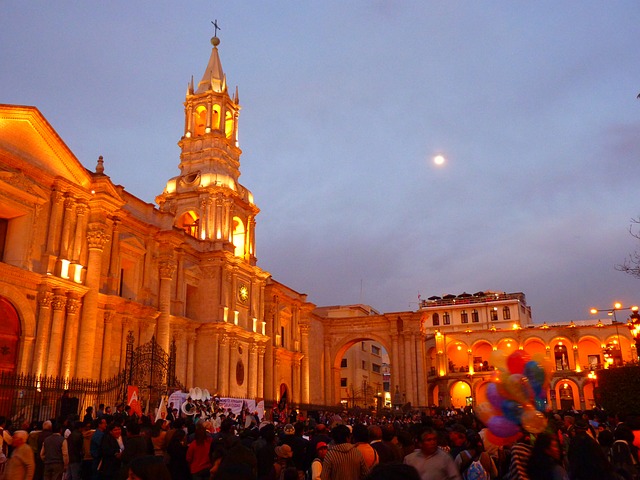Travel
Liz Weston: Beat the retiree crowds to these 5 places abroad

AREQUIPA, PERU. Low living costs combined with good infrastructure make Peru one of International Living’s top 10 places to retire for 2018. Arequipa offers big-city amenities – it’s the country’s second largest, with more than 800,000 people – and a “spring-like” moderate climate year round. It’s also UNESCO World Heritage site, singled out by the United Nations organization for its historic core filled with colonial architecture. A potential downside: its 7,661-foot elevation, which could be a problem for those who don’t handle altitudes well. (Pixabay photo)
Coronado in Panama once had pristine beaches and not much else. Today the resort town is a haven for U.S. and Canadian retirees, with strip malls, fast-food joints and a lot of people speaking English.
“For all the world, it’s like you’re in a U.S. beach town,” says Kathleen Peddicord, publisher of Live and Invest Overseas, a site and newsletter for people who want to work, invest or retire abroad.
That kind of retirement destination appeals to many who are looking for an established expatriate community where they may not have to learn another language, says Dan Prescher, a senior editor at International Living, another site for people interested in life abroad. Places like Coronado or Boquete in Panama, Puerto Vallarta or Ajijic in Mexico and Ambergris Caye island in Belize have been welcoming North American retirees for years.
If you’re looking for places before they become popular, however, you may need to be even more adventurous than the typical expat. Infrastructure that you take for granted – such as high-speed internet, paved roads, or easy access to quality health care – may not be abundantly available. When people retire abroad and then boomerang back home, unrealistic expectations are often the culprit, Prescher says.
“They leave with the expectation that the rest of the world is just like home but at half the cost,” Prescher says. “Nothing could be further from the truth.”
The rewards of seeking out less-known destinations, though, can be considerable. Living costs can be lower, and you may enjoy a more authentic experience of the country before your fellow compatriots rush in.
Here are five destinations that Peddicord and Prescher picked as the next hot retirement destinations abroad, where couples can live comfortably on less than $2,000 a month:
- AREQUIPA, PERU. Low living costs combined with good infrastructure make Peru one of International Living’s top 10 places to retire for 2018. Arequipa offers big-city amenities – it’s the country’s second largest, with more than 800,000 people – and a “spring-like” moderate climate year round. It’s also UNESCO World Heritage site, singled out by the United Nations organization for its historic core filled with colonial architecture. A potential downside: its 7,661-foot elevation, which could be a problem for those who don’t handle altitudes well.
- CASCAIS, PORTUGAL. Portugal is one of Europe’s most affordable places to live, combining modern amenities with an Old World vibe, Prescher says. Cascais , a coastal resort town about 20 miles west of Lisbon, is a former royal retreat complete with a 15th century fortress turned palace, a busy marina, spotless streets and a moderate year-round climate. A potential downside: Some expats complain about the slow-moving bureaucracy for establishing residency.
- CAYO, BELIZE. Belize is popular with U.S. expats for good reasons: English is the official language and the country exempts qualified retirees from many taxes, Peddicord says. Away from the more crowded Caribbean coastline, the inland Cayo district offers rainforests, lovely rivers and fertile soil for gardeners. Infrastructure is not great in Cayo, Peddicord says: Expect unpaved roads and fickle electricity. It’s a good fit for those looking for a simpler, back-to-basics lifestyle, she says. A potential downside: Health care “is not a strong suit,” so many expats cross the border to Mexico for high-quality medical care.
- LAS TERRENAS, DOMINICAN REPUBLIC. French settlers on Dominican Republic’s northeast peninsula give Las Terrenas a European flair, complete with French bakeries and residents who greet each other with kisses on both cheeks, Peddicord says. A new international airport nearby offers easy travel, good for quick trips back to the states or provinces. A potential downside: Health care in many areas isn’t great, although a new hospital in Las Terrenas points to an improved quality of local treatment.
- PHNOM PENH, CAMBODIA. Retirees looking for big-city living at budget prices should check out Cambodia’s capital city, Prescher says. A booming economy and rising tourist trade mean plenty of options for eating, drinking and socializing. At the same time, Phnom Penh offers some of the lowest living costs of all the expat-friendly options, so that even modest retirement incomes can buy a life of relative luxury, Prescher says. Cambodians tend to be extremely welcoming and friendly, with many speaking English as their second language. A potential downside: Flight times to North America are typically 20 hours or more, making this not a great option for those who want to make frequent trips home.





















